Rickets is a serious illness that is diagnosed in younger children during a routine examination by a pediatrician. This pathology has pronounced symptoms of a violation of the process of bone formation.
Treatment of rickets involves the use of drug therapy aimed at restoring the deficiency of minerals in the form of calcium, phosphorus, as well as dosed taking vitamin D. In combination with medications, special massages and exercise therapy exercises are used.
Record content:
- 1 What is rickets?
- 2 Causes
-
3 Symptomatic manifestations of rickets in children
- 3.1 First stage
- 3.2 The height of the disease
- 3.3 Reconvalescence
- 3.4 Residual phenomena
-
4 The degree of rickets and the course of the disease
- 4.1 Mild rickets
- 4.2 Moderate degree of rickets
- 4.3 Severe rickets
- 5 Features of rickets in premature babies
- 6 Which doctor should I go to?
- 7 Diagnostics
-
8 Treatment of full-term and premature babies
- 8.1 Vitamin therapy
- 8.2 Massage
- 8.3 Power features
- 9 Recommendations for parents
- 10 Video about rickets
What is rickets?
Rickets is a disease of the musculoskeletal system, which in infants is characterized by progressive symptoms and degenerative processes in the structure of bone tissue.
The main symptom of the disease is the lack of mineralization of the bones of the spine, upper and lower extremities, pelvis. The main reason for the development of this disease is a chronic deficiency of vitamin D, as well as its metabolic compounds.
Early symptoms of rickets are found in children based on the results of X-ray examination of the structure of the long bones. As the disease progresses, other signs of bone demineralization are added. Treatment of pathology is aimed at replenishing the acute deficiency of vitamin D, calcium and phosphorus.
Causes
Rickets in children may have a primary etiology, when the disease occurs solely due to vitamin D deficiency, or the pathology is secondary.
In this case, degenerative changes in the structure of bones develop in connection with the presence of already existing pathologies of the digestive or endocrine systems, excluding full assimilation by the body of compounds of vitamin D, calcium, phosphorus and other minerals vital for the formation of healthy bone tissue in breastfeeding children age.
Pediatricians identify the following negative factors, the influence of which becomes the cause of the development of rickets in children:
- insufficient stay of the child in the fresh air under the ultraviolet radiation of the sun, which is necessary for the synthesis of a sufficient amount of vitamin D in the skin;

- a meager or unbalanced diet, when a child is fed artificial mixtures, the composition of which is not enriched with essential minerals or vitamin D (in the period of breastfeeding, a similar reason can also occur if a lactating mother restricts herself in food, and her milk is poor in nutritious elements);
- the onset of premature labor activity with the birth of a premature baby;
- diseases of the intestines, liver and digestive system receptors, which ensure the absorption, recognition of vitamin D, as well as its transformation into an active metabolite of vitamin D3;
- physiological predisposition to the development of rickets (this disease is most often diagnosed in children of the Negroid race);
- bad heredity, when the child's blood relatives were ill from this pathology of insufficient bone mineralization.
Rickets in children (symptoms and treatment are determined in a health care institution based on the results of a diagnostic examination) occurs in all countries of the world. Despite this, there is a regional prevalence of this disease.
For example, this pathology of the development of the musculoskeletal system is especially common in countries with dusty, dirty and damp air, through which ultraviolet rays pass worse.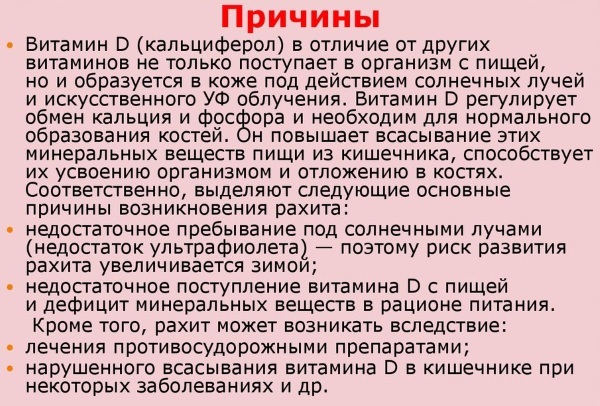
Children born in large metropolitan areas with densely built-up multi-storey buildings are at risk. A child born in the server region in late autumn or winter is also prone to developing rickets due to a seasonal decrease in solar activity.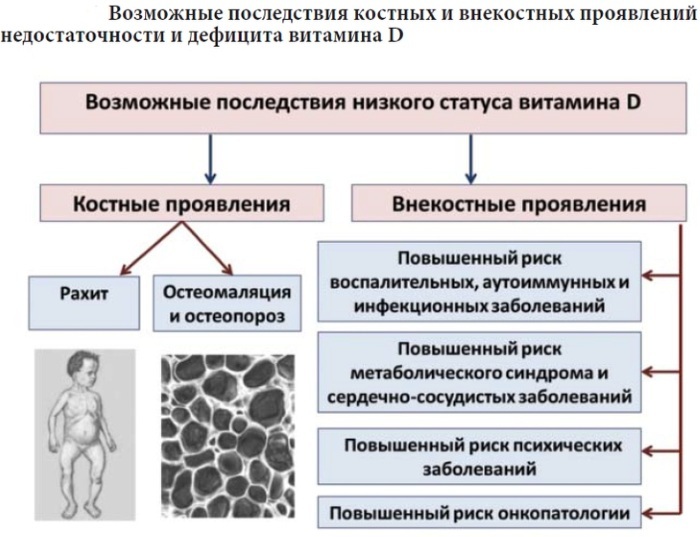
Children of all peoples of the world who profess a nomadic lifestyle are in the fresh air almost all the time, the occurrence of rickets is practically not found. There is also a direct pattern that the likelihood of developing this disease in a child lactating with breast milk is 70% lower than in the case of feeding with artificial formula.
Symptomatic manifestations of rickets in children
Rickets in children (symptoms and treatment of the disease should be determined by a pediatrician) is manifested by degenerative changes in the structure of bone tissue. The lower limbs are the first to suffer.
Then the pathology disrupts the formation of all other elements of the musculoskeletal system. The saturation of symptoms depends on the duration of the development of the disease, its severity and the severity of the deficiency of vitamin D, calcium, phosphorus.
First stage
The initial period of the onset of rickets is manifested by characteristic signs when the child reaches the age 3-4 months, but in most cases, parents do not notice pathological changes in development newborn.
The main symptoms of the initial stage of rickets are as follows:
- the child becomes moody, does not sleep well, wakes up often and also falls asleep suddenly;
- infants with rickets react irritably to a light source;
- there is a sharp decrease in appetite (the baby refuses to breastfeed, or else does it sluggishly without showing initiative);
- the first signs of dysfunctional disorders in the work of the intestines appear, which are most often accompanied by constipation;
- the child is characterized by increased sweating, which is especially pronounced at night (a newborn can sweat a lot in a room with a comfortable air temperature);
- increased sweating, combined with itching of the skin surface (this symptom makes the baby rub head on the surface of the pillow, which leads to the appearance of baldness characteristic of rickets for most occiput);
- the smell of the sweat of sick children has a pungent sour smell;
- decreased muscle tone, which can only be determined by an experienced pediatrician.
At the initial stage of rickets, degenerative changes in the bone tissue have not yet been traced. In especially severe cases of the development of the disease, an increased softness of the edges of the fontanelle may be found. This symptom should alert the parents of the child. The average duration of development of the initial stage of rickets is from 14 to 30 days.
The height of the disease
During the height of rickets, pathological changes occur in the structure of bone tissues. A sick child observes osteomalacia of the lower extremities, chest, on the surface of the frontal and the parietal part of the head, bumps appear, the presence of which is a consequence of degenerative processes skull.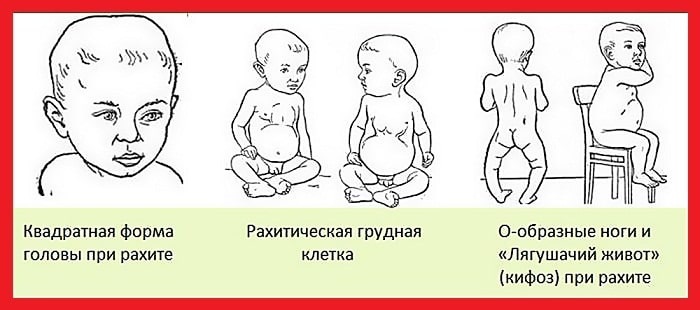
During the height of rickets, sick children begin to lag behind in mental and physical development. The risk of mental and neurological disorders increases. The duration of this stage in the progression of the disease depends on the causes that caused it, as well as the degree of deficiency of vitamin D, minerals calcium and phosphorus.
Reconvalescence
With the onset of the stage of convalescence, the pathological and deformational changes in all parts of the musculoskeletal system cease. The presence of this stage indicates the patient's recovery, as well as the complete disappearance of the symptoms of rickets.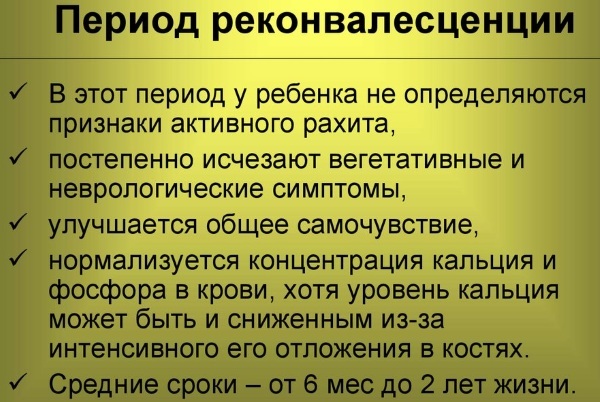
The restoration of the body can occur under the influence of drugs that have been prescribed for admission in order to neutralize acute deficiency of vitamin D, minerals calcium and phosphorus, or due to the intake of these substances naturally (improvement quality of breast milk, which is fed to the baby, exposure to ultraviolet radiation, elimination of concomitant diseases of the digestive systems).
Residual phenomena
With the onset of the stage of convalescence and complete recovery, pathological changes in the structure bone tissue and the entire musculoskeletal system, are preserved with the child throughout the remaining life.
In children who have previously had rickets, the following residual effects of the disease can be observed:
- violation of posture, which is expressed in a very strong stoop, skewed spine;
- various deformational changes in the anatomical structure of the chest;
- curvature of the bones of the lower extremities;
- underdevelopment and narrowing of the pelvic bones (in girls, this pathology in the future may affect the state of health of the reproductive system, as well as make it impossible to have a child without the help of a cesarean section).
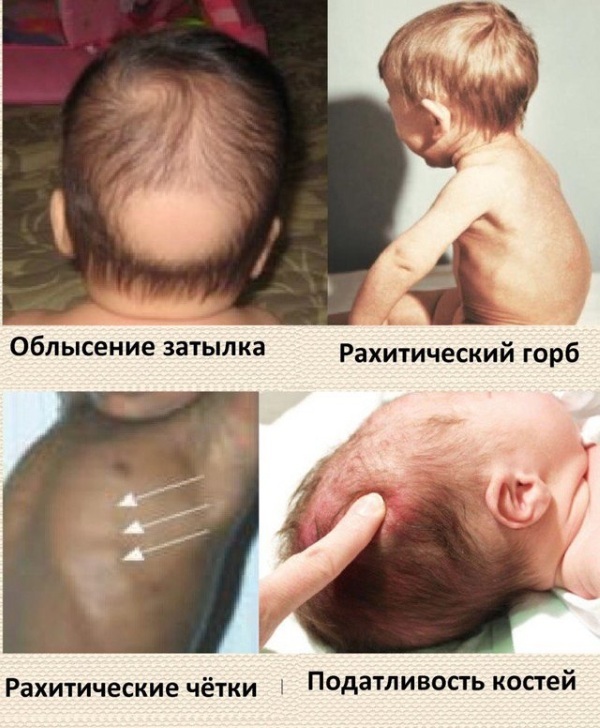
Residual effects of rickets, which led to severe curvature of the spine, deformity of the chest, immobility of the lower limbs, are the basis for the appointment of a life group to the child disability.
The degree of rickets and the course of the disease
Rickets in children (symptoms and treatment of the disease largely depend on the causes that caused the pathological condition musculoskeletal system) are classified according to the severity of deformation changes in the structure of the bone fabrics.
Mild rickets
A mild degree of rickets is the least dangerous for the child's body. Pathological changes in all elements of the musculoskeletal system are almost invisible and are completely reversible.  The mild severity of this disease corresponds to the state of the child's body at the initial stage of the development of rickets.
The mild severity of this disease corresponds to the state of the child's body at the initial stage of the development of rickets.
Moderate degree of rickets
The average severity of the disease is manifested by the classic symptoms of rickets. In the process of visual examination of the child's body, it is possible to determine moderately pronounced deformities and malformations of the lower extremities, spine, pelvic bones, chest.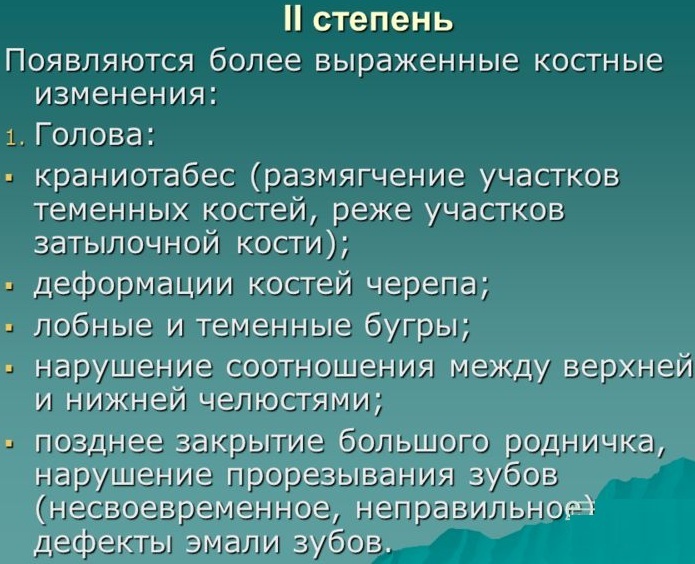
Hardware diagnostics of internal organs displays pathological changes in their tissues. At the same time, the functionality of the main life support systems of the body is preserved without signs of the development of secondary diseases.
Severe rickets
Severe rickets is the last stage in the development of this disease, which is characterized by total damage to the nervous system, bone tissue of the upper and lower extremities, chest, spine, pelvis. In sick children, various defects and anomalies of the development of internal organs are diagnosed.
A child suffering from severe rickets, in relation to his peers, lags far behind in mental and physical development. In 85% of cases, irreversible complications of rickets are associated with the occurrence of secondary diseases of the internal organs and systems of the child's body.
Features of rickets in premature babies
Rickets in children (symptoms and treatment of the disease are determined during the diagnostic examination of the child), which were born prematurely, presents with more severe signs of vitamin D deficiency and calcium-phosphorus deficiency exchange.
This is due to the fact that in the last 2 months. intrauterine development from the mother's body to the tissues of the fetus comes most of the mineral components. Babies who are born prematurely do not get the nutrients they need.
The main feature of development in a premature baby is a severe manifestation of the following symptoms:
- flattening of the bones of the occipital and temporal lobes of the head;
- rib rosary formation;
- damage to the central nervous system;
- baldness of the temples and occiput;
- the formation of large frontal tubercles;
- deformational changes in the chest towards its narrowing or pathological expansion;
- softening of the bones of the skull;
- immaturity of the skin, tissues of the liver, lungs, heart;
- severe curvature of the spine and lower extremities.
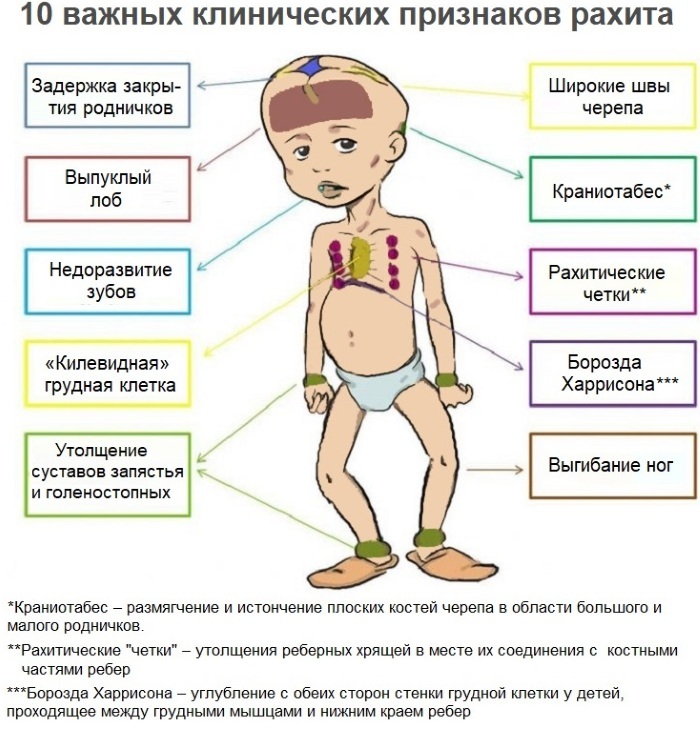
Premature babies who have had rickets suffer from severe residual effects of the disease for the rest of their lives. Most of the patients in this category who survived become disabled and lose the ability to move independently.
Which doctor should I go to?
A pediatrician is involved in the treatment of rickets in children of the neonatal period, as well as in an older child. It is to this doctor of this profile that you should seek medical help at the slightest suspicion of rickets. In this case, it is better to play it safe and become the initiator of a false alarm than to skip the initial stage of the development of the disease.
Diagnostics
An experienced pediatrician is able to diagnose the presence of rickets in a child even by the results of a visual examination of his body.
To confirm suspicions of this disease, the patient is prescribed to undergo the following examination methods:
- delivery of morning urine with a Sulkovich test, which displays the calcium concentration in the urine;

- collection of venous blood, which is examined for the level of calcium and phosphorus compounds (this biological material is also tested for alkaline phosphatase, which are always high with rickets);
- X-ray examination of individual parts of the musculoskeletal system, which allows you to see the demineralization of bones, changes in the density of their structure, deformation.
If pathological development of the upper limbs is detected, the pediatrician prescribes an ultrasound scan of the forearm bones for the child. Based on the results of the examination, the doctor draws up a scheme for the individual treatment of the patient, develops a program for the prevention of complications of rickets.
Treatment of full-term and premature babies
Therapy for children born on time, as well as those who were born prematurely, is carried out using drugs enriched with vitamin D. The techniques of therapeutic massage are also used, the rules of dietary nutrition are followed, aimed at enriching the child's body with missing vitamins and minerals.
Vitamin therapy
To suppress the further development of rickets in children, an oil or aqueous solution of vitamin D is used. This dosage form of this nutrient is safest for infants and older children.
Most other medicines containing vitamin D, calcium and phosphorus compounds are allowed only for children over the age of 12 years.
Treatment of rickets in children requires taking an oil solution of vitamin D2 in a dosage of 500 to 625 IU daily. The average duration of a therapeutic course is 200,000 - 250,000 IU, depending on the dynamics of the restoration of the full development of bones.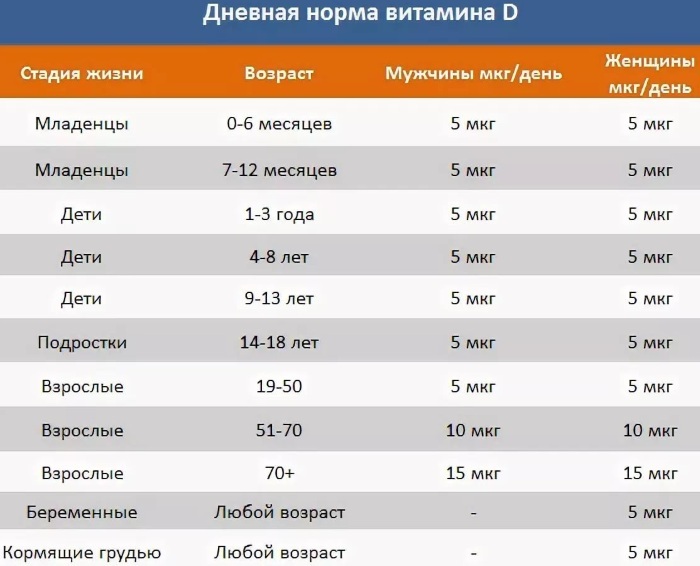
At the discretion of the attending pediatrician, the sick child may also be prescribed an aqueous solution of vitamin D3, which is taken in exactly the same dosage.
In the presence of severe stages of rickets with deformation changes in the bones of the musculoskeletal system, malformations of internal organs, the daily dose of vitamin D2 oil solution can be increased by 2000-5000 IU. The dosage of this drug is selected by the attending physician on an individual basis.
Throughout the entire course of therapy, the child should be under the supervision of doctors, since the oversaturation of the child's body with vitamin D can have a strong toxic effect. The first sign of an overdose and intoxication with this substance is nausea, loss of appetite, severe vomiting, acute urinary retention, constipation.
For the prevention of supersaturation with an oil or aqueous solution of vitamin D, it is necessary to donate morning urine at least once every 14-20 days in order to conduct the Sulkovich test.
This analysis will allow you to effectively control the concentration of calcium in the child's body. If the test result is positive, then this indicates an overdose of vitamin D. Vitamin therapy should be discontinued.
Massage
During the treatment of rickets by taking an oily or aqueous solution of vitamin D, it is recommended to include massage in the therapeutic course. During the day, it is necessary to warm up the muscle tissues of the upper and lower extremities, back, neck and chest 2-3 times.
Massage movements should be intense, have an impact not only on the muscles of the child, but also on the elements of the musculoskeletal system.
The massage is performed in an arbitrary form and is aimed at improving blood circulation in those parts of the body that are changed under the influence of rickets. Together with blood flow, a large amount of nutrients are delivered, which makes it possible to more effectively fight the manifestations of the disease.
Power features
After the first signs of rickets appear, as well as in order to prevent this disease, the diet of the child and mother, lactating a newborn with breast milk, should include food with an increased concentration of vitamin D, calcium and phosphorus. The table below lists products that are allowed and contraindicated for children suffering from rickets.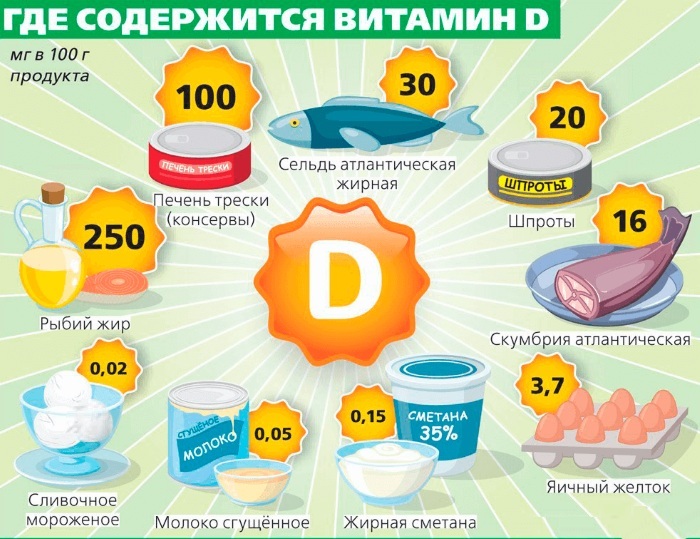
| Allowed Products | Forbidden food |
|
|
At the same time, food containing preservatives, emulsifiers, food colors and other components of the food industry should be avoided.
Recommendations for parents
Parents who want to minimize the likelihood of developing rickets in a child, must daily comply with the following rules for the prevention of this disease:
- provide the child with regular walks in the fresh air, the duration of which should be at least 1 hour per day;
- balance the diet;
- show the child to the pediatrician in a timely manner to perform routine examinations;
- not to engage in independent elimination of symptoms that resemble the initial stage of rickets;
- timely treat diseases of the digestive system that disrupt the absorption of vitamin D and other nutrients;
- for women who are in a state of pregnancy, eat a sufficient amount of ocean and sea fish, as well as lactic acid products.
Rickets is a serious and dangerous disease that leads to demineralization of bones, disruption of the absorption of vitamin D, mineral complexes of calcium and phosphorus. This disease is diagnosed in newborn infants and older children. Symptoms of the disease are expressed in the deformation of the lower extremities, chest, spine, ribs, small pelvis.
Children with rickets lag behind in mental and physical development, suffer from acquired defects of internal organs. Treatment of pathology includes saturation of the child's body with an additional amount of oil and an aqueous solution of vitamin D. The duration of therapy continues until complete recovery.
Video about rickets
Komarvsky about rickets and vitamin D:



